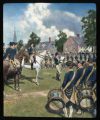
AN: Fort Hope is around the same location of Port Elizabeth in OTL.
+++++
Entry in the Worldwide Online Encyclopedia (WOE), Edited on January 12th of 2025:
"Fort Hope, often known as "Hope Cape" or "FH," is a major port city and the third biggest city in the Federal Republic of South Africa (FRSA). Founded in 1791, Fort Hope served as an outpost for American traders that were traveling between the Americas and Asia. The area which Fort Hope was built upon was purchased by the United States in 1790 (Treaty of Amsterdam [1790]). Former president Samuel Kim negotiated with the Dutch East India Company and attempted to purchase the eastern parts of modern-day FRSA, which was far away from the center of the Dutch Cape Colony (1652-1807) based around Cape Town. However, the Dutch East India Company representatives refused to concede any part of the colony to the United States. The Dutch East India Company sought to retain control of the Asian trade, as the trade flowing from Dutch possessions in Southeast Asia and India increasingly grew to be profitable. Additionally, the Company had no jurisdiction in the area that Kim sought to acquire for the United States. In fact, the area was primarily occupied by the Xhosa people at the time and was not settled by Dutch colonists. As such, the Dutch East India Company rejected Kim's proposals outright. Instead, they offered an adjusted deal that would allow the United States to maintain a small outpost in the coastal areas away from the Dutch settlements. The Treaty of Amsterdam was signed by both parties in 1790 and for a price of five hundred thousand dollars, the United States was granted a charter to establish a trading port outside of the Cape Colony's territorial boundaries. An American expedition arrived in 1791 to settle the area and built a fort for protection. This fort was named "Fort Hope" by the leader of the expedition (an Army colonel by the name of Napoleon "Nathaniel" Bonapart) and marked the beginning of Fort Hope's existence. The town was visited by Kim several times in its early years (as Kim would travel to Asia four times over his lifetime).
The outpost moderately grew in size over the coming years from a small fort occupied by a few traders and soldiers to a thriving town of three thousand individuals by the year 1807. While most of the three thousand inhabitants were from the United States, with many of them being traders, the town also boasted a significant African population. In particular, a thousand or so of the city's population were Zulu and Xhosa people. With the United States adopting an early policy of equality, the nation was able to cooperate with native tribes in the region with greater ease than the Netherlands. While the Zulu and Xhosa people were not entirely friendly with the Americans (indeed, as American South Africa grew in size and influence after the Fourth Anglo-Dutch War in 1806, tension between the two groups rose), the United States sought to avoid direct conflict with the natives and formed an amicable relationship with them. The official policy of the United States was of "peaceful co-existence," where the United States cooperated with natives and allowed them to move to Fort Hope if they so desired. Natives were not treated as "inferior" beings and were seen as equals, which was set as the law of South Africa during its time as an American protectorate (from 1807 to 1922) and as a republic (from 1922 onwards) (for racial conflicts in South Africa, see article South Africa Civil War). The native population in Fort Hope served as laborers and farmers (small areas around Fort Hope were claimed by the American government for farming and expansion) and even served as auxiliaries at times to protect the town (some of these native auxiliaries would go on to serve in the Angl-American War of 1832).
As Fort Hope grew into a trade port, it attracted the attention of European traders traveling to Asia and served as a resupply point between the two continents. By the year 1830, the town grew to 60,000 inhabitants and served as an important center of trade and commerce in the area. With the dissolution of the Dutch Cape Colony and the establishment of the American Cape Protectorate after the collapse of the Dutch trade empire during the Fourth Anglo-Dutch War of 1806, the town grew rapidly in size (as it was unrestricted by the treaty set between the Netherlands and the United States) and maintained its own independent government that was separate from the American federal government. However, the growth of Fort Hope simmered tensions between the city and Cape Town, which saw Fort Hope as competition to its economic growth and immigration. Additionally, the pro-native policies adopted by the administration in Fort Hope served as another conflict of interest between the two zones (the former Dutch controlled Cape Town area and the American influenced Fort Hope area). This would all lead to the eventual civil war in South Africa...
Fort Hope also played a crucial role in the Anglo-American War of 1832 and would earn the nickname "the Rock of Africa" due to its perseverance and part during the war..."



Awesome chapter




















Good bye Boers war

 Thanks for the chapter
Thanks for the chapter
